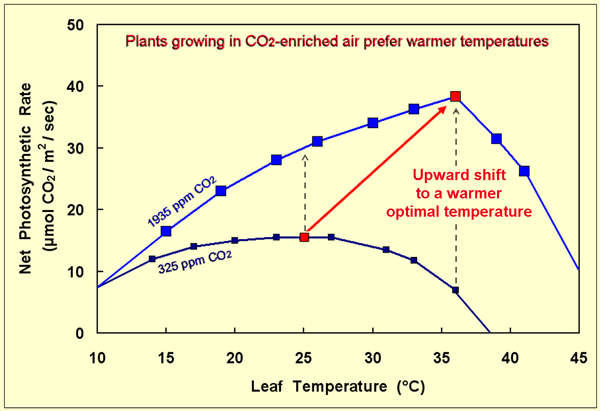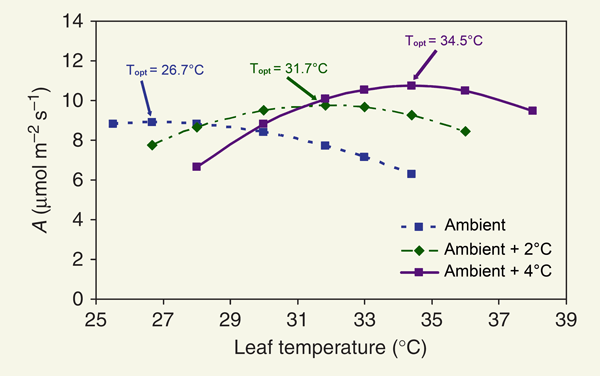The State of Earth's Terrestrial Biosphere:
How is it Responding to Rising Atmospheric CO2 and Warmer Temperatures?
The Future
In spite of the overwhelming amount of evidence presented in the preceding sections of this report, demonstrating that rising atmospheric CO2 concentrations and warmer temperatures have enhanced the productivity of the biosphere, concerns have been expressed that these trends will gradually decline -- and eventually reverse -- if temperatures rise toward the upper limits projected in future model-based scenarios of global warming.
In all likelihood, however, the greening of the planet will continue in the years and decades to come, even if the largest temperature increases predicted by the models happen to occur. This is because the optimum temperature for plant growth and development typically rises with increasing levels of atmospheric CO2; and this response, coupled with expected increases in plant photosynthetic rates from the rise in the air's CO2 concentration, has been shown to be more than enough to totally compensate for any temperature-induced plant stress caused by the worst-case scenario of climate-model-predicted CO2-induced global warming.
This phenomenon was demonstrated years ago by Jurik et al. (1984), who exposed bigtooth aspen leaves to atmospheric CO2 concentrations of 325 and 1935 ppm and measured their photosynthetic rates at a number of different temperatures. Figure 29 below reproduces their results and slightly extends the two relationships defined by their data to both warmer and cooler conditions.

Figure 29. Net photosynthesis of big tooth aspen leaves growing under two concentrations of atmospheric carbon dioxide at various temperatures. Adapted from Jurik et al. (1984).
As can be seen in that figure, at 10°C, elevated CO2 has essentially no effect on net photosynthesis in this particular species, as Idso and Idso (1994) have demonstrated is characteristic of plants in general. At 25°C, however, where the net photosynthetic rate of the leaves exposed to 325 ppm CO2 is maximal, the extra CO2 of this study boosts the net photosynthetic rate of the foliage by nearly 100%; and at 36°C, where the net photosynthetic rate of the leaves exposed to 1935 ppm CO2 is maximal, the extra CO2 boosts the net photosynthetic rate of the foliage by 450%. In addition, it is readily seen that the extra CO2 increases the optimum temperature for net photosynthesis in this species by about 11°C: from 25°C in air of 325 ppm CO2 to 36°C in air of 1935 ppm CO2.
In viewing the warm-temperature extensions of the two relationships at the right-hand side of the figure, it can also be seen that the transition from positive to negative net photosynthesis - which denotes a change from life-sustaining to life-depleting conditions - likely occurs somewhere in the vicinity of 39°C in air of 325 ppm CO2 but somewhere in the vicinity of 50°C in air of 1935 ppm CO2. Thus, not only was the optimum temperature for the growth of bigtooth aspen greatly increased by the extra CO2 of this experiment, so too was the temperature above which life cannot be sustained also increased, and by about the same amount, i.e., 11°C.
Other researchers have also documented this important CO2-induced plant benefit in numerous other agricultural, grassland and woody plant species, nearly all of which studies indicate that a 300 ppm increase in the air's CO2 content increases a plant's optimum temperature for growth and development by a mean of approximately 6°C (Bjorkman et al., 1978; Berry and Bjorkman, 1980; Nilsen et al., 1983; Jurik et al., 1984; Seeman et al., 1984; Harley et al., 1986; Stuhlfauth and Fock, 1990; McMurtrie et al., 1992; McMurtrie and Wang, 1993; Idso et al., 1995; Cowling and Sykes, 1999; Gutierrez et al., 2009). And this response is more than enough to totally compensate for any temperature-induced plant stress caused by the worst-case scenario of climate-model-predicted CO2-induced global warming. And additional research indicates that plants may be able to boost their optimum temperature for photosynthesis as the temperature warms, even in the absence of a concurrent increase in atmospheric CO2.
Such can be concluded from the work of Gunderson et al. (2010), who investigated the "photosynthetic sensitivity to temperature and the potential for acclimation in relation to the climatic provenance of five species of deciduous trees, Liquidambar styraciflua [sweetgum], Quercus rubra [northern red oak], Quercus falcata [southern red oak], Betula alleghaniensis [yellow birch] and Populus grandidentata [bigtooth aspen]." Their experiment was conducted out-of-doors within open-top chambers that were maintained at three different temperature regimes - ambient, ambient plus 2, and 4°C above ambient - for a period of three years. Based on their analysis, the five scientists report that "warming treatments resulted in a shift in the temperature response curves for CO2 assimilation, such that leaves in warmer treatments had higher temperature optima [Topt]," an example of which phenomenon is depicted in the figure below for Q. rubra seedlings during one specific month.

Figure 30. Net CO2 assimilation rate vs. leaf temperature in Quercus rubra seedlings during June of 2003 in the ambient (A) and elevated (A+2°C and A+4°C) temperature treatments. Adapted from Gunderson et al. (2010).
As may be seen from Figure 30, the trees growing in progressively warmer environments had progressively higher Topt values; and there was a tendency for the net CO2 assimilation rates at those higher Topt values to be a bit higher as well. Gunderson et al. additionally found that this adjustment in photosynthetic response was typically accomplished over a period of as little as two days; while indicating that "others have found all or most acclimation within 2-6 days (Veres and Williams, 1984; Hill et al., 1988; Battaglia et al., 1996; Turnbull et al., 2002; Froux et al., 2004)." They also state that a similar "adjustment of thermal optima was confirmed in all species, whether temperatures varied with season or treatment, and regardless of climate in the species' range or provenance of the plant material," and they say that the observed "responses to the temperature manipulation were not different from the seasonal acclimation observed in mature indigenous trees," which they also investigated locally.
In light of all these observations, it would indeed appear that Earth's plants will be able to successfully adjust their physiology to accommodate a warming of the magnitude and rate-of-rise that is typically predicted by climate alarmists to accompany the projected future increase in the air's CO2 content. In fact, if the planet's flora can adjust their physiology to not only survive a modest instantaneous warming of 2-4°C, but to actually benefit from it, as has been demonstrated to be the case in several trees examined by Gunderson et al., there is little reason not to believe that they would respond to a similar warming projected to develop over a century or more. And when one factors in the aerial fertilization effect of the rising atmospheric CO2 concentration, plus its transpiration-reducing effect that boosts plant water use efficiency, as well as CO2's ability to also raise the Topt values of most plants, the world's vegetation is seen to possess the ideal mix of ingredients to reap a tremendous benefit. As such, we expect that the recent greening of the planet observed by so many scientists will continue in the years and decades to come, notwithstanding alarmist concerns to the contrary.




